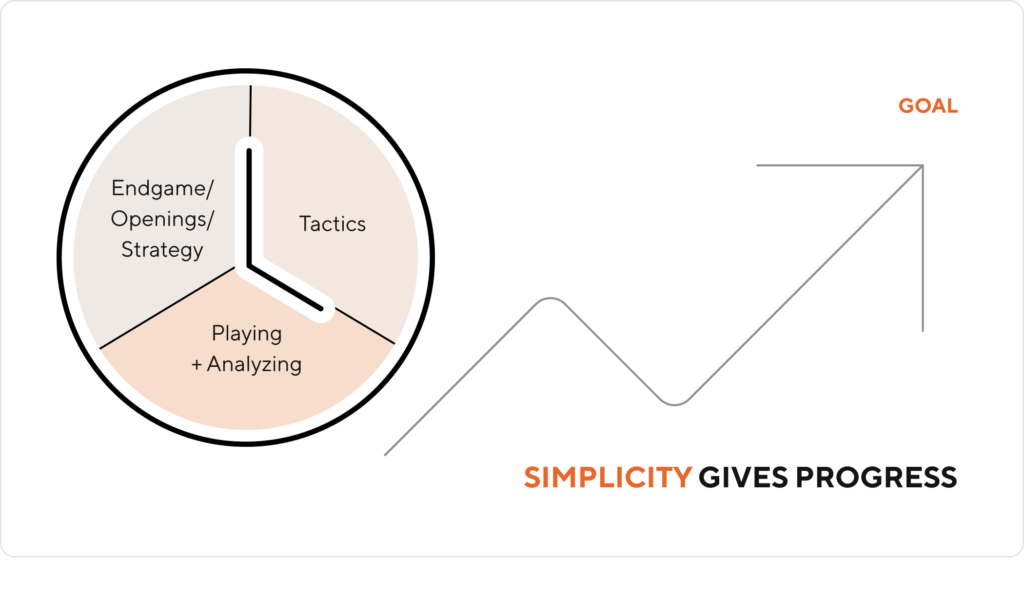This is Day 4 of my 7-Day series to kickstart your Chess Training. Each part stands on its own, but they are the most powerful if you read and apply all 7 days consecutively.
- Day 1 – The Chess Detox
- Day 2 – Mastering Mindset: Shift From Rating Goals to Skill Improvement
- Day 3 – Transforming Your Chess: The Power of Hard Training
Chess improvement isn’t linear. Your rating graph doesn’t go up in a straight line. Nor does every hour you study amount to the same improvement.
The differences are actually quite staggering.
Ever heard of the Pareto principle, also called the 80/20 principle? It says that 80% of outcomes are derived from 20% of inputs. And it applies to economics, sports, health, chess, and basically anywhere else.
With limited time, our goal should be to focus on what makes a big difference and say no to everything else. To do the 20%, that amounts to 80% of our improvement, and leave out the rest.
You can and should apply this principle in three main ways for strategic Chess Training:
- Focus mostly on the area that gives the biggest improvements (main areas are: Openings / Tactics / Positional Play / Endgame / Playing & Analyzing Games)
- In each area, focus on the 20% that matters most (avoid lengthy opening theory; just learn the main lines and ideas)
- Only use the most high-quality resources (here it is rather 99-1) and say no to mediocre or even good things
The 1/3 Rule
To make your life easier, I’ve come up with a simple rule to determine which areas you should focus on in Chess Training. It is called the 1/3 rule and is very simple:
- 1/3 of your Chess Training time should be spent on Tactics
- 1/3 on Playing + Analyzing Games
- and for the last 1/3, you rotate between Openings/Endgames/Positional play

This is a simple way to ensure you spend a lot of time on what matters most (the 20%), which in Chess improvement clearly are Tactics and Playing + Analyzing games.
Looking at Playing + Analyzing games as part of our Training also fits in with your new mindset: we focus on improving our skills first.
Is the 1/3 rule the perfect one-fit-all solution, and is everyone doing another split doing something wrong?
Hell no.
That’s not the point. What the 1/3 rule does is bring simplicity to your training and push you toward doing things that really make a difference in Chess. So, especially if you’ve never managed to stick to a consistent plan before, I highly recommend following the 1/3 rule for starters.
It won’t be the *perfect* Training plan, but it will be pretty darn good.
Life Is Always A Trade-Off
Two things are key to using the ladder two ways of the 80/20 principle:
- You can’t do everything
- Whenever you choose something, you need to say no to something else
I get crazy when I read Chess advice on Twitter saying:
“5 must-read books on pawn play for Beginners” or “10 strategy books everyone must read”
I might even agree that the books are good. But these advice-givers do not fully understand that everything is a trade-off in life. From my experience, an average motivated adult improver spends between 1 and 2 hours a day on chess improvement.
Reading five books on pawn play will take you several months of only studying pawn play at that rate. That’s absolutely bonkers.
Someone following the 80/20 principle will instead:
- Learn the basic tactical motifs
- Study all endgame theory they really need to know
- Get familiar with opening principles
- Play + Analyze dozens if not hundreds of games
It might not be that obvious at first, but these nicely meant “must-read” recommendations of Books, videos & courses are what make so many of you overwhelmed and confused.
Repeat after me: whenever I say yes to something, I say no to 100 other things.
With that mindset, the bar for future Chess material rises tremendously. You will never even have time to study all *amazing* chess books, so please don’t waste your time on decent ones that aren’t meant for your level.
Instead of “Is This Good?” Ask, “Is this essential?”
From now on, when you read advice on a new book or course, raise the bar and ask yourself, “Is this essential for me?”
- Solving Tactics, Yes. Learning the key ideas and first moves of an opening, Yes.
- Having GM Like opening prep: no. Knowing how to mate with B+N: no. Knowing how to attack weak pawns when you still blunder pieces: no.
The best of it all: once you admit to yourself that you can’t do it all and you will not read many good, maybe even great, Chess books in your lifetime, a big weight falls off your shoulders.
Saying no will get easier. And you can work on a simple plan, consistently, without constant fear of missing out. Because if you know you will miss 80% of chess improvement content on purpose, there is no need to be afraid anymore.
Remember my NLT student who felt “Free like a bird”? It was both because of getting rid of bad habits and realizing he couldn’t do it all. That’s why, in the course, I recommend only very few resources. This doesn’t mean everything else is bad. It simply means those are the “hell yeah” resources, amazing, and proven to work.
Once you have those, you can feel confident saying no to everything else.
Keep improving,
Noël
Want to read on? Day 5 – Crafting Your SMART Winning Chess Plan